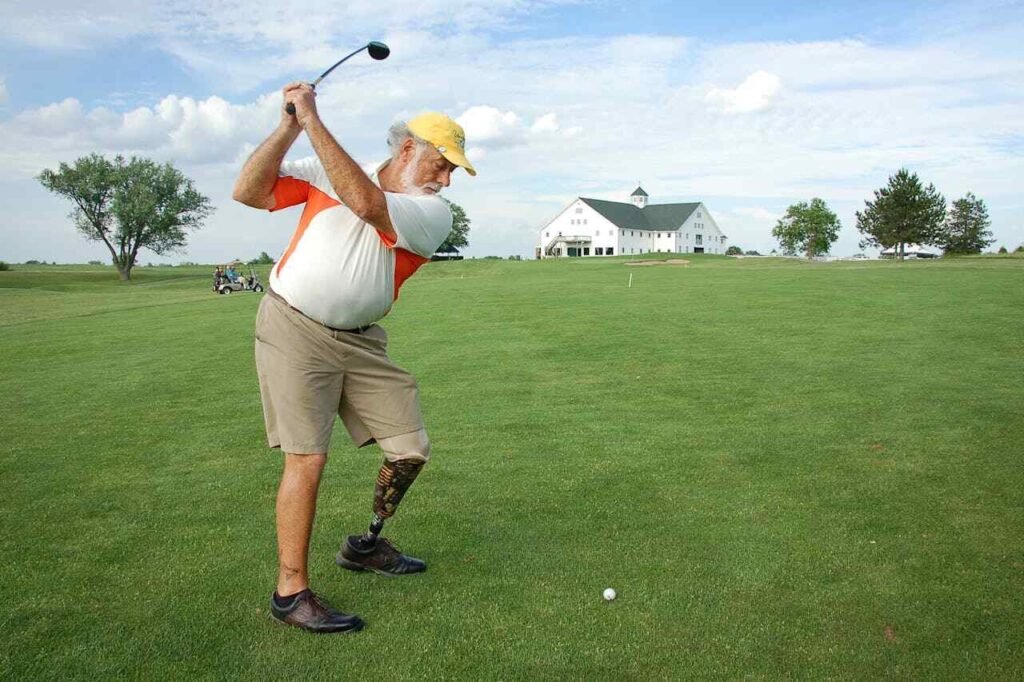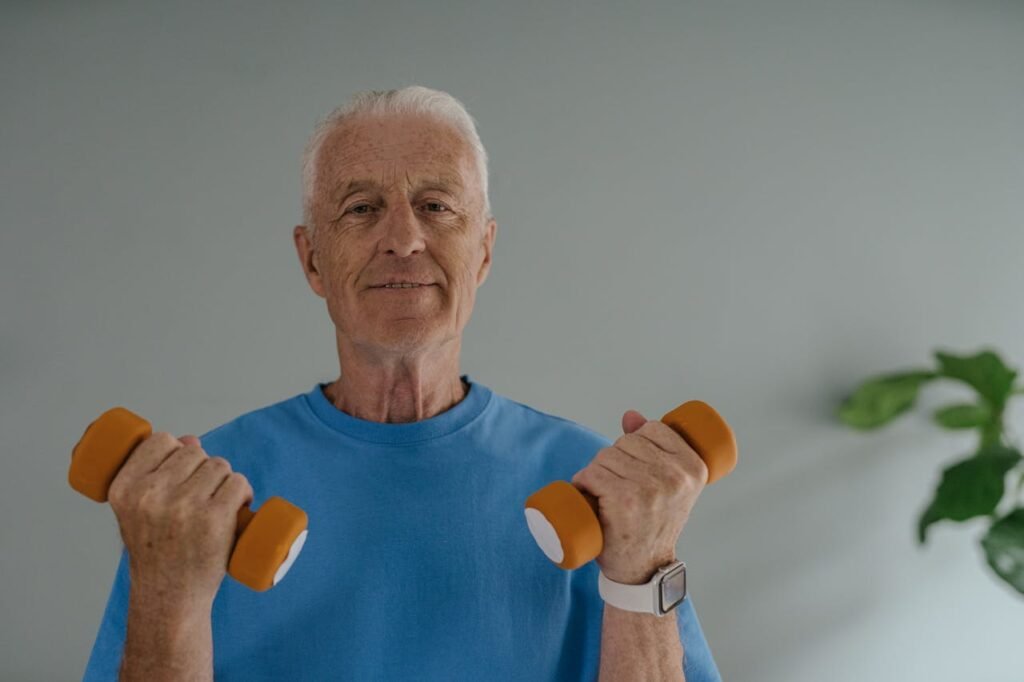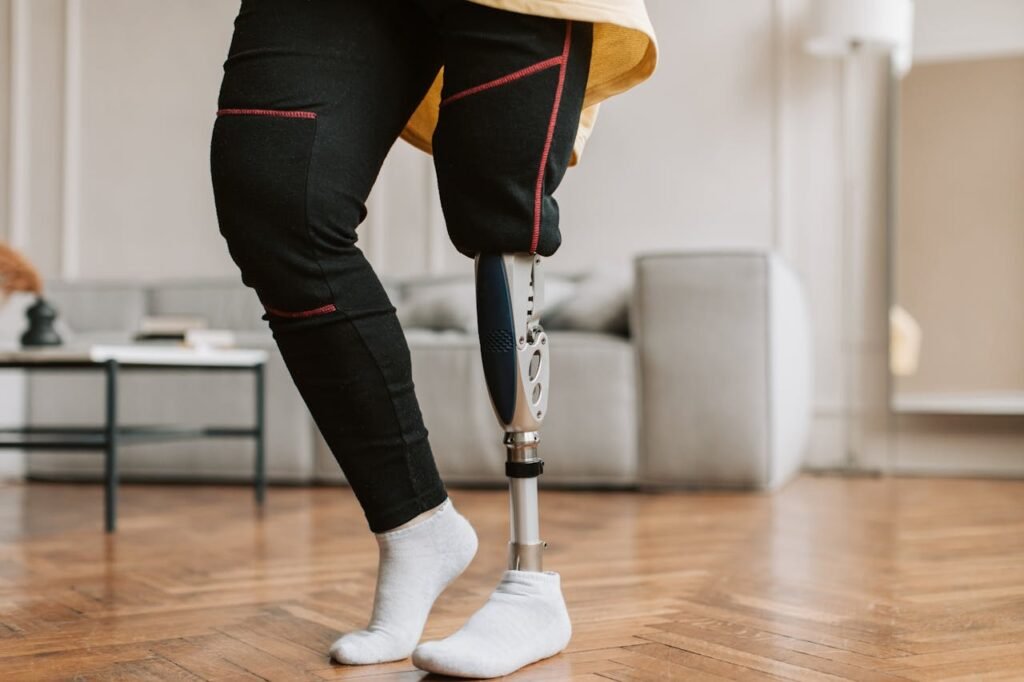Comfort is everything. When you use a prosthetic limb, even the smallest detail can change how your day feels. A well-fitted prosthesis gives you confidence to walk, move, and live freely—but the real secret to lasting comfort lies in what’s underneath: your socks, your liners, and the care you give your skin.
For seniors, this becomes even more important. As skin becomes thinner and more sensitive with age, it needs extra attention to stay healthy. A little daily care can prevent irritation, protect your limb, and help your prosthesis feel like a natural part of your body.
At RoboBionics, we’ve worked with hundreds of seniors across India who share the same goal—to move with comfort and dignity every day. This guide will help you understand how to choose, use, and care for your prosthetic socks and liners, and how to keep your skin feeling good from morning to night.
How Socks, Liners, and Skin Care Work Together
The Connection Between the Three

Your prosthetic comfort depends on balance—between your limb, your liner, and your sock. Each layer has a role to play. Together, they protect your skin, manage pressure, and keep your prosthesis fitting just right.
Think of your liner as a soft cushion that hugs your limb. The sock adjusts that fit, filling any small gaps and controlling how your prosthesis feels throughout the day. And your skin? It’s the foundation that holds everything together.
When one of these layers isn’t cared for properly, the others suffer too. A damp sock, a dirty liner, or dry skin can turn comfort into discomfort. Keeping all three clean and cared for is the key to all-day ease.
Why Seniors Need Special Care
As we grow older, skin becomes thinner, drier, and less elastic. It loses some of its natural oil, which makes it easier to get irritated. For seniors using prosthetics, that means more chances of friction, redness, or sores.
Extra care doesn’t have to be complicated. It simply means being gentle, staying clean, and checking your skin regularly.
A good routine keeps you moving comfortably and helps prevent issues before they start.
The Role of Proper Fit
Even the best liner or sock won’t feel right if your prosthesis doesn’t fit well. A proper fit ensures even pressure and steady support, protecting your skin from unnecessary friction.
If you notice new pain, rubbing, or looseness, it’s important to visit your prosthetist. Sometimes, small changes in weight or swelling can affect your fit.
Remember—comfort starts with alignment. Your socks, liners, and skin care only work best when your prosthesis sits perfectly.
Understanding Prosthetic Socks
What Prosthetic Socks Do
Prosthetic socks might look simple, but they have a big job. They cushion your limb, absorb moisture, and adjust the space between your skin and socket.
They come in different thicknesses (called ply). Thicker socks fill more space if your limb volume changes during the day. Thinner ones help when you need a tighter fit.
By switching between socks, you can control how your prosthesis feels from morning to evening—when your limb naturally swells or shrinks a little.
Choosing the Right Material
Most prosthetic socks are made from cotton, wool, nylon, or modern blends. Each has its own feel and benefits.
Cotton feels soft and breathable, perfect for warm weather. Wool absorbs moisture without feeling damp, keeping your skin dry. Nylon or synthetic blends are durable and stretch easily, giving a snug fit.
If you have sensitive skin, try hypoallergenic materials. Your prosthetist can help you find the type that feels best against your skin.
How to Wear and Adjust Socks
Always smooth your prosthetic sock before putting on your liner or prosthesis. Wrinkles or folds can cause pressure points that irritate the skin.
If your prosthesis feels loose or heavy during the day, add a thin sock layer. If it feels tight, remove one.
This flexibility keeps your fit consistent. Adjusting your socks isn’t about perfection—it’s about comfort that changes with your body.
Cleaning and Caring for Your Socks
Your socks collect sweat and oils from your skin, so washing them daily is essential. Use mild soap and lukewarm water, and rinse thoroughly. Avoid harsh detergents that can dry the fabric.
After washing, air dry them completely before the next use. Never wear damp socks—they increase friction and can irritate the skin.
A clean sock is more than hygiene—it’s protection for your skin and your prosthesis.
Understanding Prosthetic Liners
What Liners Are and Why They Matter
A liner is the soft layer that sits directly against your skin. It cushions your limb, absorbs impact, and helps the prosthesis stay in place.
Most modern liners are made of silicone, gel, or thermoplastic elastomer. These materials are designed to feel smooth, reduce friction, and provide gentle compression.
For seniors, liners play a big role in preventing skin breakdown and keeping the prosthesis secure.
Silicone, Gel, and Soft Liners
Silicone liners are firm, durable, and give strong support. They’re ideal if you have an active lifestyle or use your prosthesis for longer periods.
Gel liners feel softer and provide excellent cushioning. They’re perfect for sensitive skin or for seniors who prefer a gentler fit.
Soft or thermoplastic liners are lightweight and flexible, making them easier to handle for those with reduced hand strength.
Choosing the right liner depends on your comfort needs and your daily activity.
How to Wear a Liner Properly
Before wearing your liner, make sure your skin is completely dry. Even a little moisture can cause slippage or discomfort.
Roll the liner onto your limb gently, rather than pulling it up. This helps remove air pockets and ensures smooth contact with your skin.
Once the liner is on, check for folds or trapped hairs, which can cause irritation or pain. Small details make a big difference in long-term comfort.
Cleaning and Maintenance
Your liner should be cleaned every day. Use mild soap and warm water to remove sweat and oils. Rinse thoroughly and let it air dry upside down on a clean towel.
Avoid strong cleaning chemicals—they can damage the material or leave residues that irritate your skin.
Once dry, inspect it for cracks, stickiness, or thinning. A worn liner can cause rubbing and should be replaced when it loses its shape or smoothness.
Keeping your liner clean is the simplest way to keep your prosthesis fresh and your skin healthy.
Skin Care for Prosthetic Users
Why Skin Health Matters

Your skin is your body’s first layer of protection. It faces constant pressure, friction, and heat from your prosthesis. Without proper care, it can easily become dry, sore, or infected.
Healthy skin keeps your prosthesis comfortable. When your skin is smooth, clean, and well-moisturized, your liner and sock can do their job properly.
Taking a few minutes each day for skin care is a simple investment that saves you from pain later.
Daily Cleaning Routine
Wash your residual limb every morning and night with mild, fragrance-free soap and warm water. Use your hands instead of rough cloths to avoid irritation.
After washing, dry gently with a soft towel. Pay attention to folds or areas where moisture may stay trapped.
Clean, dry skin is the foundation for comfort. It helps prevent rashes, odor, and bacterial growth that can make wearing a prosthesis unpleasant.
Moisturizing the Right Way
Moisturizer keeps your skin soft and prevents cracking, but timing is important. Apply it before bed instead of right before wearing your prosthesis.
That way, your skin absorbs it fully overnight and stays smooth without making the liner slippery in the morning.
Choose creams or lotions without alcohol or strong scents. If you’re unsure which to use, your prosthetist or dermatologist can recommend a gentle option.
Managing Sweat and Friction
Sweat is a common challenge, especially in warm weather. Moisture trapped inside the socket can lead to irritation or infections.
Use moisture-wicking socks or liners that allow air to circulate. Some liners are designed with special fabrics that keep the skin dry.
If sweating remains an issue, speak with your prosthetist—they may suggest antiperspirant sprays or breathable accessories made for prosthetic users.
Checking Your Skin Regularly
Look at your skin every day, especially after removing your prosthesis. Early signs of trouble include redness, blisters, bumps, or dry patches.
If you see any of these, give your limb time to rest and clean it thoroughly. If irritation continues for more than a few days, consult a professional.
Regular checking prevents small issues from turning into infections or sores.
Troubleshooting Skin Problems
Recognizing Early Signs of Irritation
The sooner you spot a skin issue, the easier it is to fix. Common early signs include redness, itching, or a warm feeling on your limb. These may mean your skin is reacting to friction, moisture, or pressure.
If you notice small blisters or areas of tenderness, remove your prosthesis and give your skin time to breathe. Sometimes, irritation comes from wearing the same sock thickness too long or from trapped sweat.
Most of these problems can be solved with rest, cleaning, and adjustments. But ignoring them can lead to deeper sores that take longer to heal.
When the Skin Becomes Too Dry
Dry skin cracks easily, especially under pressure. This can cause painful splits or scabs that make wearing your prosthesis uncomfortable.
To prevent this, keep your skin lightly moisturized every night. Use gentle, fragrance-free creams and massage them in small circles to help blood flow.
Avoid using lotions just before wearing your prosthesis. Moist skin can cause the liner to slide and create friction instead of cushion. Timing is everything—nighttime moisturizing is best.
Dealing with Sweating or Dampness
Seniors often notice more sweating under their prosthesis, especially during warmer months or activity. This can make the socket slippery and irritate the skin.
Change your socks if they feel damp, and clean your liner whenever you remove your prosthesis for a break. Some users find that wearing thinner socks or moisture-control fabrics helps keep the area cool.
If sweating remains excessive, ask your prosthetist about antiperspirant solutions designed for prosthetic use. Avoid regular sprays—they can damage liners or irritate skin.
Redness and Pressure Marks
A little redness is normal after removing your prosthesis—it should fade within 15 to 20 minutes. But if redness stays or turns into soreness, it’s a sign of uneven pressure.
This can happen when your liner shifts or when your prosthesis fit changes slightly. Try adjusting your sock thickness or check that your liner is smooth.
If redness becomes painful or develops blisters, contact your prosthetist for a fit check. It’s better to correct the cause early than to treat an injury later.
Itching and Skin Rashes
Itchy skin under the liner can result from sweat, soap residue, or fabric irritation. Wash your limb and liner thoroughly and ensure both are dry before wearing your prosthesis again.
Avoid scratching—it breaks the skin and increases infection risk. If itching continues, switch to a different soap or liner material.
Persistent rashes should always be examined by a professional, as they may be caused by allergies or bacteria.
Adjusting Liners and Socks for Daily Comfort
Managing Limb Volume Changes

Your residual limb naturally changes size throughout the day. It may be smaller in the morning and slightly larger by evening due to fluid movement.
This is where adjusting your socks becomes important. Adding or removing a thin layer keeps your prosthesis fitting snugly without pressure or looseness.
Listen to your body. If your prosthesis feels heavy or pulls downward, it might be too loose. If it feels tight or pinches, remove a layer. Comfort is your best guide.
Knowing When to Replace Liners or Socks
Over time, liners stretch and lose shape, while socks thin out or develop rough spots. Both can affect comfort and skin safety.
If your liner starts to feel sticky, cracked, or loose, it’s time to replace it. For socks, replace them when they no longer feel soft or when the elastic wears out.
Using worn accessories can lead to poor fit and friction, even if your prosthesis is perfect. Fresh materials always protect your skin better.
Layering for the Perfect Fit
Sometimes, one sock isn’t enough. You might need to combine thin and thick socks to achieve a balanced fit.
Start with a thinner sock and add another only if your limb feels too loose in the socket. Always keep the surface smooth—no folds or wrinkles.
Even small layering adjustments make a big difference in stability and comfort during movement.
Using Gel Pads or Cushions
For seniors who experience tenderness on certain spots, gel pads or soft cushions can provide relief. They add gentle support where your limb needs it most.
These pads fit between your liner and socket or replace extra sock layers. Ask your prosthetist before trying them to ensure they don’t affect alignment.
Proper placement of padding turns uneven pressure into comfort that lasts all day.
Daily Habits for Long-Term Comfort
Keeping Everything Clean
Cleanliness is the foundation of comfort. Wash your skin, liner, and socks daily. This routine prevents bacteria, odor, and irritation from building up.
Always rinse thoroughly and dry completely before wearing your prosthesis again. Moisture trapped anywhere is the enemy of healthy skin.
Keeping your gear fresh doesn’t just feel better—it extends its life and keeps you safe.
Allowing Skin to Breathe
Your skin needs air to stay strong. Each day, spend some time without your prosthesis to let your limb breathe.
Resting for even 15 minutes gives your skin a chance to recover from pressure and moisture.
During this time, elevate your leg slightly to improve circulation. This small pause helps prevent swelling and irritation.
Using the Right Cleaning Tools
Avoid using harsh scrubs or rough towels on your residual limb. Instead, use your hands or a soft cloth to wash.
Choose soaps with neutral pH and without perfume. Harsh ingredients can strip natural oils and lead to dryness or itching.
If you clean your liner with a cloth, use one reserved only for that purpose. Keeping cleaning tools separate prevents cross-contamination.
Staying Hydrated and Eating Well
Healthy skin begins inside your body. Drink plenty of water throughout the day to keep your skin soft and elastic.
Foods rich in vitamins A, C, and E—like fruits, vegetables, and nuts—help your skin heal faster and stay strong.
A balanced diet supports everything from muscle strength to circulation, both of which help your prosthesis feel better each day.
Rest and Movement Balance
Too much sitting can lead to stiffness; too much movement without rest can cause friction. Find balance by alternating gentle motion with short breaks.
When resting, remove your prosthesis to let your skin relax. When active, make sure your liner and socks fit smoothly to prevent rubbing.
Comfort comes from listening to your body’s signals and respecting its rhythm.
Nighttime Skin and Prosthetic Care
Evening Cleaning Routine
Your skin and prosthesis need care before bed just as much as in the morning.
Remove your prosthesis gently and wash your limb with warm water and mild soap. Rinse and dry it well, especially in areas that sweat more.
Clean your liner and socks too, so they’re fresh for the next morning. A clean routine every night prevents odor and irritation.
Nighttime Moisturizing
Before you sleep, apply a gentle moisturizer to your residual limb. Massage it in with soft circular motions to boost circulation.
Avoid heavy, oily creams that may block pores. Choose light, breathable moisturizers that absorb easily.
Let your skin rest uncovered for a while to allow air circulation before covering it with light fabric if needed.
Relaxation Before Sleep
Stress affects your skin too. A calm mind helps your body recover overnight.
Before bed, take a few slow breaths or stretch your shoulders and legs lightly. This releases tension and improves blood flow to your limb.
Better relaxation leads to healthier skin and deeper, more peaceful sleep.
Checking Skin Before Bed
Just before turning in, take a final look at your limb. Any new redness or spots should be noted. Early detection helps you care for issues before they worsen.
If your skin feels sore or hot, rest without the prosthesis and allow it to recover overnight. You can use a soft compression sock if mild swelling appears.
Small steps at night protect your comfort in the morning.
Long-Term Care and Professional Support
Building a Routine That Works

Consistency is the secret. A few minutes of daily cleaning, moisturizing, and checking your fit will keep your skin and prosthesis healthy for years.
Once you find what works—stick to it. A simple, regular habit always outperforms complicated routines you can’t sustain.
This daily rhythm turns maintenance into second nature, making every day smoother.
Regular Prosthetist Visits
Even if everything feels fine, regular checkups are essential. Your prosthetist can spot fit or material issues before they cause problems.
They may also recommend new liners or updated materials that suit your skin better as your body changes with time.
Think of these visits as preventive care for comfort and confidence.
Replacing Parts on Time
Worn liners or socks can undo all your hard work. Replace them as soon as they start feeling loose, sticky, or rough.
Old materials can harbor bacteria or cause friction burns. A fresh replacement ensures a comfortable and hygienic fit.
Investing in replacements saves you from discomfort later—it’s part of caring for yourself.
Adapting to Seasonal Changes
Weather can change how your skin behaves. In humid months, focus on cleanliness and dryness. In colder weather, emphasize moisture and warmth.
Adjust your socks, liners, and care products to match the season. Small changes keep your comfort steady all year long.
Your prosthetist can guide you on seasonal adjustments specific to your material type and daily routine.
Partnering with RoboBionics for Ongoing Care
At RoboBionics, we understand that comfort is more than design—it’s daily life. That’s why our prosthetics are built for smooth interaction with your skin, liners, and socks.
We support seniors through personalized fittings, follow-ups, and expert advice on long-term care. Our goal is to make every step, every moment, as comfortable as possible.
When your skin feels good, your confidence grows—and that’s where true independence begins.
If you’d like personalized advice or want to explore advanced prosthetic solutions designed for seniors, you can book a demo with our experts at robobionics.in/bookdemo.



